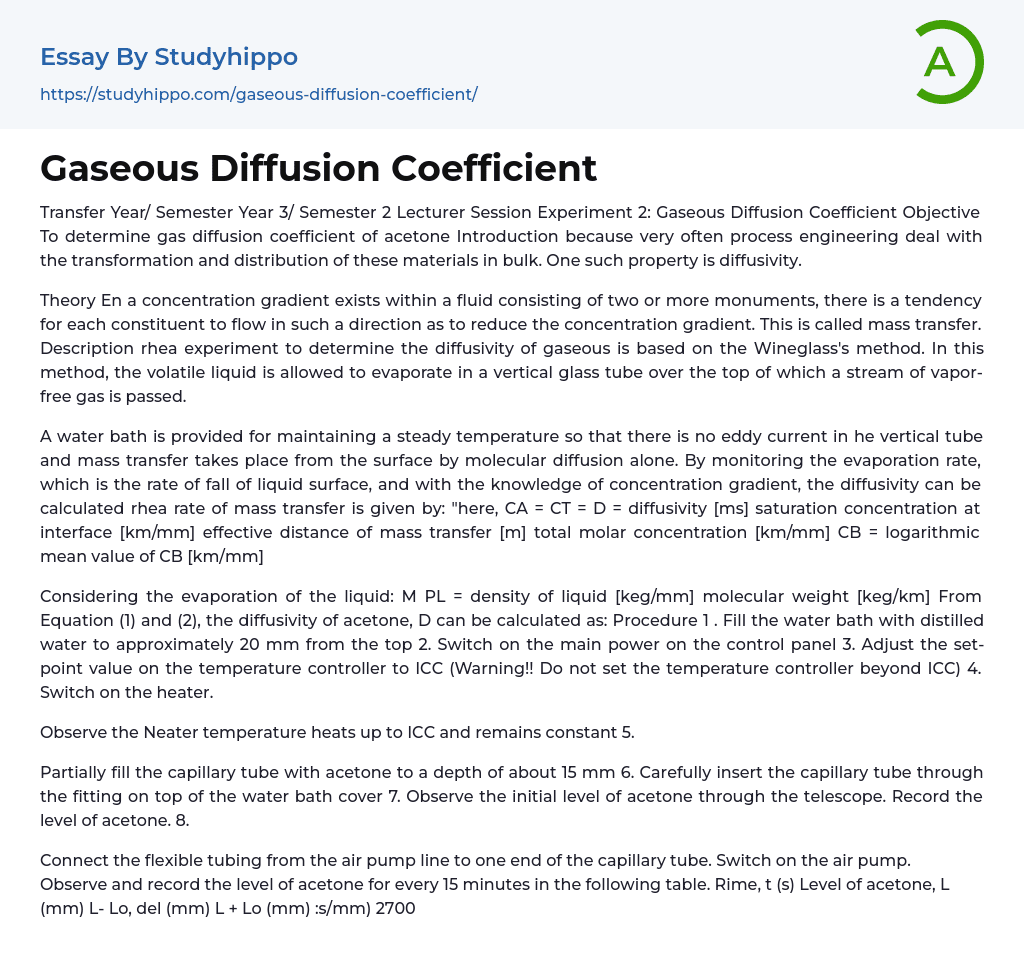Gaseous Diffusion Coefficient Objective
To determine gas diffusion coefficient of acetone Introduction because very often process engineering deal with the transformation and distribution of these materials in bulk. One such property is diffusivity.
Theory En a concentration gradient exists within a fluid consisting of two or more monuments, there is a tendency for each constituent to flow in such a direction as to reduce the concentration gradient. This is called mass transfer. Description rhea experiment to determine the diffusivity of gaseous is based on the Wineglass's method. In this method, the volatile liquid is allowed to evaporate in a vertical glass tube over the top of which a stream of vapor-free gas is passed.
A water bath is provided for maintaining a steady temperature so that there is no eddy current in he vertical tube and m
...ass transfer takes place from the surface by molecular diffusion alone. By monitoring the evaporation rate, which is the rate of fall of liquid surface, and with the knowledge of concentration gradient, the diffusivity can be calculated rhea rate of mass transfer is given by: "here, CA = CT = D = diffusivity [ms] saturation concentration at interface [km/mm] effective distance of mass transfer [m] total molar concentration [km/mm] CB = logarithmic mean value of CB [km/mm]
Considering the evaporation of the liquid: M PL = density of liquid [keg/mm] molecular weight [keg/km] From Equation (1) and (2), the diffusivity of acetone, D can be calculated as:
Procedure
- Fill the water bath with distilled water to approximately 20 mm from the top
- Switch on the main power on the control panel
- Adjust the set-point value on the temperatur
controller to ICC (Warning!! Do not set the temperature controller beyond ICC)
Switch on the air pump. Observe and record the level of acetone for every 15 minutes in the following table. Rime, t (s) Level of acetone, L (mm) L- Lo, del (mm) L + Lo (mm) :s/mm) 2700
- Bottled Water essays
- Acid essays
- Calcium essays
- Carbohydrate essays
- Carbon essays
- Chemical Bond essays
- Chemical Reaction essays
- Chemical reactions essays
- Chromatography essays
- Concentration essays
- Copper essays
- Diffusion essays
- Ethanol essays
- Hydrogen essays
- Organic Chemistry essays
- Osmosis essays
- Periodic Table essays
- Ph essays
- Salt essays
- Sodium essays
- Titration essays
- Atom essays
- Big Bang Theory essays
- Density essays
- Electricity essays
- Energy essays
- Force essays
- Heat essays
- Light essays
- Motion essays
- Nuclear Power essays
- Physiology essays
- Sound essays
- Speed essays
- Temperature essays
- Thermodynamics essays
- Atmosphere essays
- Biodiversity essays
- Coral Reef essays
- Desert essays
- Earth essays
- Ecosystem essays
- Forest essays
- Lake essays
- Natural Environment essays
- Ocean essays
- Oxygen essays
- Rainbow essays
- Sea essays
- Soil essays




